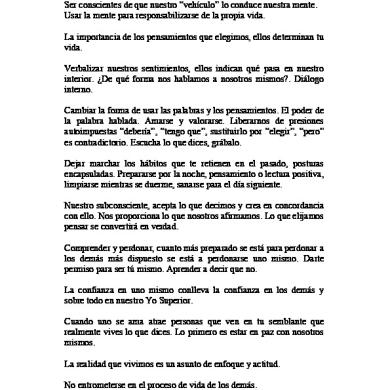Management Survey Developing Attitude Survey
This document was uploaded by user and they confirmed that they have the permission to share it. If you are author or own the copyright of this book, please report to us by using this DMCA report form. Report DMCA
Overview
Download & View Management Survey Developing Attitude Survey as PDF for free.
More details
- Words: 395
- Pages: 2
KEY STEPS IN DEVELOPING AN ATTITUDE SURVEY Generally, the following steps should be completed in sequence: 1. Decide what you want to find out; 2. Select who designs the survey; 3. Determine how the survey will be conducted; 4. Check the sample in-house; 5. Communicate with employees about the survey; 6. Decide who will analyze the results and how the results will be communicated. An effective employee survey is one that would elicit answers to crucial questions. In designing these survey instruments, employers must ensure that two basic questions are asked: ____ Are employees getting what they want out of the employment relationship? ____ Is there some gripe about working conditions or supervisors that can be corrected by management? Design tips. Be specific about what you want to find out--asking too much makes it more complex and costly to analyze survey results. But enough questions should be asked to get the answers an organization needs to make decisions. Other suggestion include: ____ Get input from those who will need to use the survey results --even if an outside consultant is designing and conducting the survey. ____ Although many companies mail the surveys to employees’ homes with a stamped return envelope, employers can administer the survey on company time. ____ Regardless of how the survey is conducted, confidentiality must be guaranteed. ____ In many instances, when an outside organization develops the survey, employees will be more convinced of the company’s sincerity if they see money being spent on the survey’s administration and follow-up. ____ Announcement of the survey should come from the company’s top officer, by letter to all employees some three or four weeks before the survey, emphasizing
that (1) the survey will preserve the anonymity of the responder and (2) who will analyze the questionnaires. ____ Don’t include questions on things that the company can’t change; ____ Management must be prepared to make a thorough review of the results and make specific commitments. ____ Communicating survey results to employees is best done in face-to-face meetings with employee groups and supplemented by dissemination of results in newsletter or letter to employees; ____ Follow-up is important; if one or two departments are particularly negative, consider an additional survey and/or personal interviews with groups or randomly selected employees. ____ Surveys should be conducted annually (but not if commitments from an earlier survey have yet to be fulfilled).
that (1) the survey will preserve the anonymity of the responder and (2) who will analyze the questionnaires. ____ Don’t include questions on things that the company can’t change; ____ Management must be prepared to make a thorough review of the results and make specific commitments. ____ Communicating survey results to employees is best done in face-to-face meetings with employee groups and supplemented by dissemination of results in newsletter or letter to employees; ____ Follow-up is important; if one or two departments are particularly negative, consider an additional survey and/or personal interviews with groups or randomly selected employees. ____ Surveys should be conducted annually (but not if commitments from an earlier survey have yet to be fulfilled).
Related Documents

Management Survey Developing Attitude Survey
April 2020 7
Do-reading Attitude Survey
August 2019 16
Attitude Survey - Portrait
October 2019 16
Vals (value Attitude & Lifestyle Survey)
April 2020 1
Survey
October 2019 23
Survey
April 2020 15More Documents from ""

Tarefa 2.2.docx
April 2020 6
Management Orientation Duties
April 2020 5
Management Positive Recruitment
April 2020 8

